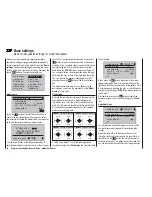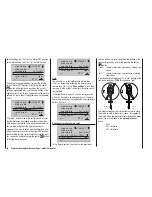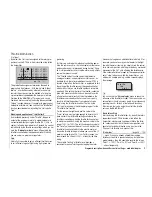
74
Program description: transmitter control settings - fi xed-wing model
Transmitter control settings
Basic procedures for assigning transmitter controls and switches
I5
I6
I7
+
tr v
+100% +100%
+100% +100%
+100% +100%
free
I8
+100% +100%
free
free
free
In addition to the two dual-axis stick units for the control
functions 1 to 4, the
mx-16
HoTT is fi tted as standard
with a range of supplementary controls:
Two three-position switches: SW 4/5 or CTRL 9 and
•
SW 6/7 or CTRL 10. These are assigned in this menu
as “CTRL 9” and “CTR 10” respectively.
Three rotary proportional controls: CTRL 6, 7 and
•
8. These are included in the menu as “CTRL 6”,
“CTRL 7” and “CTRL 8”.
Three two-position switches: SW 2, 3 and 8. These
•
are indicated in the menu by “2”, “3” and “8” plus a
switch symbol, which indicates the direction of opera-
tion of the switch.
Two momentary switches: SW 1 and SW 9. These
•
are indicated by “1” and “9” plus a switch symbol and
direction indicator, as mentioned above.
The two dual-axis stick units directly affect the servos
connected to receiver outputs 1 … 4 (assuming that you
have set up a newly initialised model memory with the
model type “Fixed-wing model”). In contrast, the “sup-
plementary” transmitter controls listed above are inactive
when the transmitter is in its default state (as delivered).
As already mentioned on page 20, this means that the
transmitter in its basic form only controls servos con-
nected to receiver outputs 1 … 4 using the primary
sticks - even when you have initialised a new model
memory with the model type “Fixed-wing model” and
“bound” it to the receiver you intend to install. Any servos
connected to receiver sockets 5 … 8 simply stay at their
centre point when you operate the associated transmit-
ter controls.
This may seem rather inconvenient at fi rst sight, but
it is the only way to ensure that you can select any of
the “supplementary” transmitter controls for any task
you like, and that you are not required deliberately to
“program away” the transmitter controls which are not
required for a particular model.
Any superfl uous transmitter control will have an
effect on your model if you operate it by mistake -
unless it is inactive, i. e. unless no function is assi-
gned to it.
That is why you can select these “supplementary” trans-
mitter controls with complete freedom in the “Transmitter
control settings” menu and assign them to any function
input (see page 38) you like, as this method ensures
that the transmitter meets your own requirements
exactly. This also means that each of these transmitter
controls can be assigned to several functions simulta-
neously. For example, the same toggle switch SW X,
which you assign to an input in this menu, can also be
assigned as the On / Off switch controlling the “Timers”
in the “
Basic settings
” menu.
The basic procedure:
Select the appropriate input I5 … I8 using the arrow
1.
buttons
cd
of the left or right-hand touch-key.
If necessary, use the arrow buttons
2.
ef
of the left or
right-hand touch-key to switch to the desired column.
Touch the central
3.
SET
button of the right-hand touch-
key, and the corresponding input fi eld is highlighted.
Operate the transmitter control you wish to use, and
4.
set the desired value using the arrow buttons of the
right-hand touch-key.
Touch the central
5.
SET
button of the right-hand touch-
key to conclude the input process.
Simultaneously pressing the
6.
cd
or
ef
buttons
of the right-hand touch-key (
CLEAR
) resets any set-
tings you have entered to the appropriate default val-
ue.
Column 2 “Assigning transmitter controls and
switches”
Select one of the function inputs 5 to 8 using the
cd
buttons of the right-hand touch-key.
Touch the central
SET
button of the right-hand touch-key
to activate the assignment facility.
I5
+
tr v
free
I8 free
+100% +100%
+100% +100%
operate desired
switch or control
Now move the appropriate transmitter control (CTRL
6 to 10), or operate the selected switch (SW 1 to 3, 8
or 9). Note that the rotary proportional controls are not
detected until they have moved a few “ratchet clicks”, i. e.
they need to be operated for slightly longer. If the travel
is not suffi cient for the transmitter to detect it, move the
control in the opposite direction.
If you assign one of the two-position switches, then this
control channel works like an On / Off switch. It is then
possible to switch to and fro between two end-point
values using this simple switch, e. g. motor ON / OFF.
The three-position switches SW 4/5 and 6/7, which you
Summary of Contents for mx-16 HOTT
Page 7: ...7 For your notes...
Page 37: ...37 For your notes...
Page 41: ...41 For your notes...
Page 45: ...45 For your notes...
Page 51: ...51 For your notes...
Page 55: ...55 For your notes...
Page 81: ...81 For your notes...
Page 103: ...103 For your notes...
Page 133: ...133 For your notes...
Page 141: ...141 For your notes...
Page 161: ...161 For your notes...
Page 173: ...173 For your notes...






























